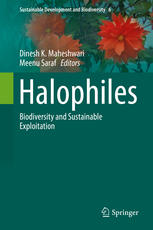

Most ebook files are in PDF format, so you can easily read them using various software such as Foxit Reader or directly on the Google Chrome browser.
Some ebook files are released by publishers in other formats such as .awz, .mobi, .epub, .fb2, etc. You may need to install specific software to read these formats on mobile/PC, such as Calibre.
Please read the tutorial at this link: https://ebookbell.com/faq
We offer FREE conversion to the popular formats you request; however, this may take some time. Therefore, right after payment, please email us, and we will try to provide the service as quickly as possible.
For some exceptional file formats or broken links (if any), please refrain from opening any disputes. Instead, email us first, and we will try to assist within a maximum of 6 hours.
EbookBell Team

0.0
0 reviewsThe world of halophiles is quite diverse and their representatives in three domains of life i.e. archaea, bacteria and eukarya. They are found all over the small subunit rRNA based tree of life and these micro-organisms are adapted to salt concentration up to saturation hence able to grow at >300g/l Nacl concentration. Their metabolic diversity is high as well encompassing oxygenic and anoxygenic phototrophs, aerobic heterotrophs, denitrifiers, sulphate reducers, fermenters and methanogens. The proteins of halophiles are magnificently engineered to function in a milieu containing 2-5M salt that encodes genes represent a valuable repository and resource for reconstruction and visualizing processes of habitat selection and adaptive evolution. Search for new enzymes endowed with novel activities and enhanced stability continues to be desirable purpose for important commercial production of biotechnological significance. These poly extremophiles proved excellent source of enzymes and metabolites possessing inherent ability to function in extreme conditions of high salt, alkaline pH and facilitating catalysis for industrial application in food processing, industrial bioconversion, bioremediation etc. In fact, it has just begun to realize the great potential and true extent of diversity and suitable applications if explored them judiciously. This book highlights current applications and research on halophiles to provide a timely overview. Chapters are written by expert authors from around the world and include topics of varied importance which include their role to play in enzyme production, restoration of soil fertility and plant growth , antimicrobial and biocatalytic potential, biomolecules in nanotechnology and aspects of quorum sensing. The book is divided into three sections, dealing with biodiversity, biotechnology and sustainable exploitation of halophiles. This major new work represents a valuable source of information to all those scientists interested in microorganisms in general and extremophiles in particular with respect to their innovative products and applications.